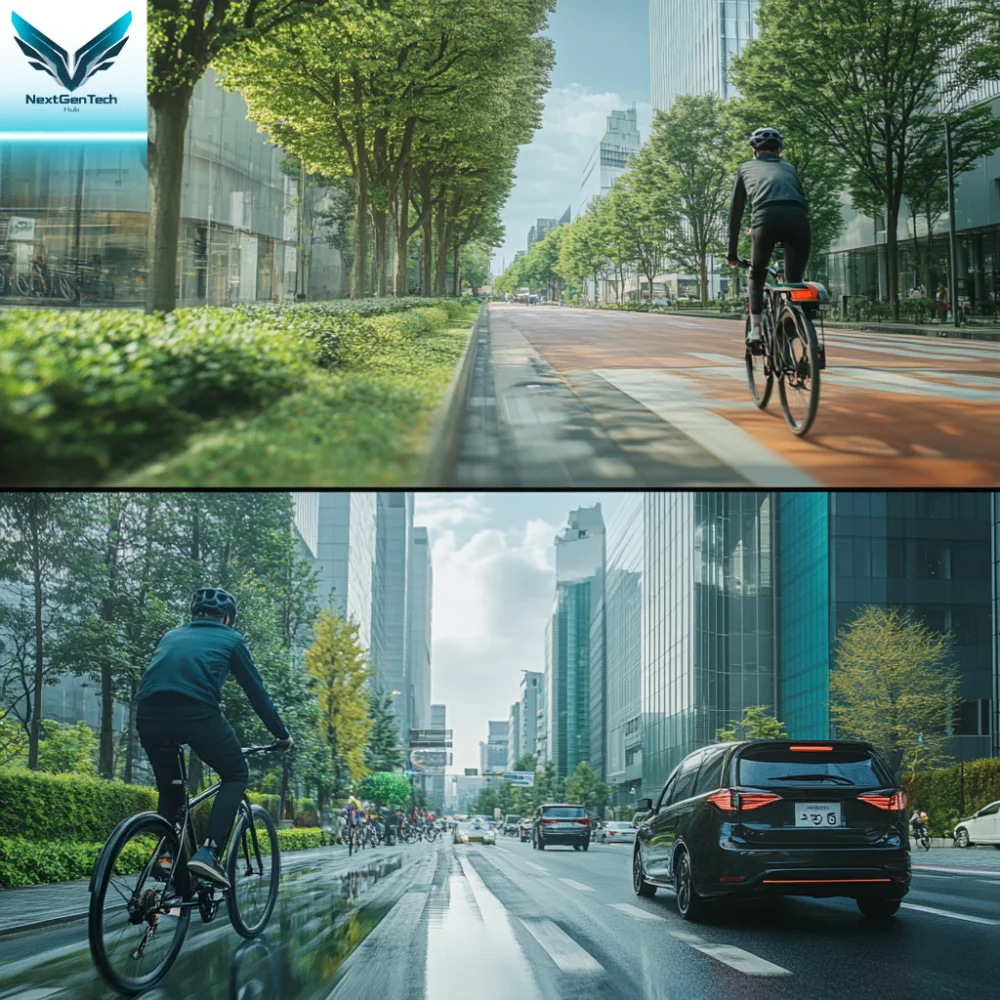Introduction

As we continue to witness rapid advancements in technology, electric bikes (e-bikes) have emerged as a transformative mode of transportation. Combining the traditional aspects of cycling with modern electric power, e-bikes offer a greener, more efficient way to commute, exercise, and explore. This guide will take you through everything you need to know about electric bikes in 2024, providing insights on how they work, their benefits, how to choose the right one, and an overview of the latest models available in the market.
Why Electric Bikes Are the Future of Transportation

The surge in e-bike popularity is not just a trend; it’s a response to the increasing demand for sustainable, cost-effective, and convenient transportation solutions. Global urbanization, the push for environmental conservation, and the need for efficient commuting options have all contributed to the rise of electric bikes.
Market Growth and Potential
The global market for electric bikes is set to reach new heights. According to a report by Statista, the e-bike market is projected to grow significantly over the next few years, with an estimated value surpassing $70 billion by 2027. This growth is fueled by increasing investments in bike-friendly infrastructure, technological advancements in battery and motor efficiency, and a growing consumer base that values eco-friendly transportation options.
Understanding Electric Bikes: How Do They Work?

An electric bike is a bicycle equipped with an electric motor and a battery, providing an extra push to your pedaling. Here’s how an e-bike functions:
- Pedal Assistance: When you pedal, the electric motor engages to provide assistance, making it easier to cycle, especially uphill or over long distances. This assistance can be adjusted, allowing you to decide how much help you want from the motor.
- Battery Power: The heart of an e-bike’s power is its battery, usually lithium-ion, which is rechargeable. The battery powers the motor, and its capacity determines the range of the bike – how far you can travel on a single charge. Battery capacities typically range from 250Wh to 750Wh, with some high-end models offering even more.
- Control Interface: E-bikes come with a control interface, often on the handlebars, where you can select the level of motor assistance, monitor battery life, and keep track of speed and distance. Some modern e-bikes even offer app connectivity, allowing you to control settings and view detailed ride data from your smartphone.
- Braking and Safety Features: E-bikes are equipped with standard bicycle brakes, and many models feature regenerative braking, which helps recharge the battery as you brake. This not only extends the range but also adds to the overall safety of the bike.
Types of Electric Bikes: Which One Suits You?

Electric bikes come in several types, each tailored to different needs and riding conditions:
- Commuter E-Bikes: Ideal for urban environments, these bikes are designed for daily commuting. They typically feature upright seating, efficient battery life, and integrated accessories like lights and racks, making them perfect for getting around the city.
- Mountain E-Bikes: These are built for off-road adventures. With robust frames, powerful motors, and advanced suspension systems, mountain e-bikes are designed to handle rough terrains and steep inclines.
- Folding E-Bikes: Perfect for those who need to save space or combine cycling with other modes of transport, folding e-bikes are compact and portable. They are easy to store in small apartments or carry on public transportation.
- Cargo E-Bikes: These are designed for hauling heavy loads, whether it’s groceries, children, or delivery packages. Cargo e-bikes have extended frames and powerful motors to handle extra weight, making them a practical choice for families or businesses.
- Road E-Bikes: Lightweight and built for speed, road e-bikes are perfect for long-distance rides on paved roads. They prioritize performance and efficiency, often at the expense of features like suspension.
The Benefits of Owning an Electric Bike

E-bikes offer a multitude of benefits that appeal to a wide range of riders:
- Eco-Friendly Transportation: E-bikes are a green alternative to cars and motorcycles, producing zero emissions and helping to reduce your carbon footprint. By choosing an e-bike, you’re contributing to cleaner air and a healthier planet.
- Cost Savings: Compared to the costs of owning a car, e-bikes are much more affordable. There’s no need for fuel, and maintenance is typically cheaper. Charging the battery costs only a fraction of what you’d spend on gas, and parking is often free or inexpensive.
- Health and Fitness: E-bikes allow you to get regular exercise, which is beneficial for cardiovascular health, muscle strength, and mental well-being. The motor assistance makes it easier for people of all fitness levels to ride, helping you stay active without overexerting yourself.
- Convenience: E-bikes are perfect for beating traffic and parking woes in urban areas. They allow you to cover longer distances quickly and efficiently, making them ideal for commuting and errands.
- Accessibility: E-bikes make cycling accessible to more people, including older adults, those with physical limitations, and individuals recovering from injuries. The electric assistance reduces the strain, allowing you to enjoy cycling regardless of your fitness level.
Choosing the Right Electric Bike: Key Considerations

When it comes to selecting the perfect e-bike, it’s important to consider several factors:
- Purpose: Think about how you plan to use the e-bike. For daily commuting, a commuter e-bike with good battery life and comfort features is ideal. If you’re into off-road cycling, a mountain e-bike with a powerful motor and suspension is a better choice.
- Motor Type: E-bikes typically come with hub motors or mid-drive motors:
- Hub Motors: These are located in the wheel hub and are often more affordable and easier to maintain. However, they may not be as efficient on steep climbs.
- Mid-Drive Motors: Positioned near the bike’s crankshaft, mid-drive motors offer better balance and efficiency, especially on uneven terrain. They tend to be more expensive but provide a smoother ride.
- Battery Capacity: Battery capacity, measured in watt-hours (Wh), directly affects how far you can travel on a single charge. If you plan on long rides, look for a battery with at least 500Wh capacity. For daily commutes, 400Wh should suffice.
- Frame Size and Fit: A bike that fits your body size is crucial for comfort and control. Make sure to choose the right frame size based on your height and preferred riding posture.
- Additional Features: Look for features that enhance your riding experience, such as integrated lights, GPS, suspension, and hydraulic brakes. Some e-bikes offer connectivity options for smartphone apps, allowing you to track your rides and adjust settings.
- Budget: E-bikes range in price from around $1,000 for basic models to over $5,000 for premium ones. Determine your budget and prioritize features that are most important to you.
Latest Electric Bike Models in 2024: A Comparison

Here are some of the latest electric bikes available in 2024, with their features and estimated prices:
- Rad Power RadRover 6 Plus
- Price: $2,099
- Features: This all-terrain e-bike comes with a 750W motor, a 672Wh battery with up to 45 miles of range, and fat tires for tackling rough surfaces. The RadRover 6 Plus is a versatile bike, ideal for both urban commuting and off-road adventures.
- Cannondale Adventure Neo 4
- Price: $3,200
- Features: Designed for comfort, this commuter e-bike features a Bosch Active Line motor, a 400Wh battery with up to 60 miles of range, and a low-step frame for easy mounting. The Cannondale Adventure Neo 4 is perfect for those who prioritize ease of use and comfort on daily commutes.
- Specialized Turbo Vado 4.0
- Price: $3,750
- Features: The Turbo Vado 4.0 is a high-performance commuter e-bike equipped with a 250W mid-drive motor, a 710Wh battery with up to 80 miles of range, and integrated lights and fenders. It’s a great option for those looking for a sleek, powerful ride with advanced features.
- Riese & Müller Load 75
- Price: $7,500
- Features: This premium cargo e-bike features a Bosch Cargo Line motor, a dual-battery system with 1,250Wh total capacity, and a large cargo area that can handle heavy loads. The Riese & Müller Load 75 is designed for families or businesses needing reliable, heavy-duty transportation.
- Brompton Electric Explore
- Price: $3,800
- Features: A folding e-bike with a 250W front hub motor, a 300Wh battery, and a lightweight design. The Brompton Electric Explore is perfect for urban commuters who need a compact, portable bike that doesn’t compromise on performance.
Maintenance Tips for Your Electric Bike

Maintaining your e-bike is essential for keeping it in good condition and ensuring a long lifespan. Here are some maintenance tips:
- Regularly Check Tire Pressure: Proper tire pressure is crucial for a smooth ride and battery efficiency. Check your tire pressure weekly and inflate them as needed.
- Charge the Battery Properly: To extend the battery’s lifespan, avoid letting it fully discharge. Charge the battery after every ride or when it drops below 20-30%.
- Keep the Bike Clean: Dirt and grime can affect the performance of your e-bike. Clean it regularly, especially after riding in wet or muddy conditions. Use a soft cloth and gentle soap to avoid damaging components.
- Lubricate the Chain: Regular lubrication of the chain is necessary to prevent wear and tear. Apply bike-specific lubricant every few weeks or after riding in the rain.
- Check Your Brakes Regularly: It’s crucial to frequently assess the condition of your brakes to ensure they are working effectively. If you notice any signs of wear on the brake pads, make sure to replace them promptly. Reliable brakes are key to your safety while riding.
Frequently Asked Questions (FAQs) About Electric Bikes

Q: What determines how far I can travel on a single charge?
A: The distance you can travel on an e-bike with one charge is influenced by several factors including the battery’s capacity, the terrain you’re riding on, your weight, and the level of motor assistance you select. Typically, most e-bikes can cover between 20 to 70 miles per charge, but high-capacity models can push that range even further.
Q: Is special insurance required for electric bikes?
A: Insurance requirements for e-bikes can vary depending on where you live. In many areas, e-bikes are classified similarly to traditional bicycles, meaning special insurance might not be required. However, it’s always wise to check local laws and consider purchasing insurance to protect against theft or damage.
Q: Can electric bikes handle wet weather?
A: Yes, most electric bikes are built to be weather-resistant and can handle riding in the rain. However, it’s advisable to avoid riding through deep water and to be cautious on slippery surfaces. After riding in wet conditions, it’s important to clean and dry your bike to prevent potential rust or corrosion.
Q: Are electric bikes good for long-distance rides?
A: Electric bikes are quite suitable for long-distance rides, especially those equipped with larger batteries. For extended travel, look for an e-bike with a high-capacity battery (such as 500Wh or more) and consider models that allow you to carry a spare battery for additional range.
Q: Can I ride an electric bike without using the motor?
A: Yes, you can ride an e-bike without motor assistance, just like a regular bicycle. This can be particularly useful if you want to conserve battery power or prefer to get more exercise by relying on your own pedaling power.
Conclusion

Electric bikes represent a significant shift in personal transportation, offering a blend of sustainability, efficiency, and enjoyment. Whether you’re navigating city streets, venturing on scenic trails, or simply looking for a fun and convenient way to stay active, there’s an e-bike that fits your lifestyle. By understanding the various options and features available, you can confidently choose an e-bike that meets your needs and start enjoying the many benefits that this innovative mode of transport offers.
